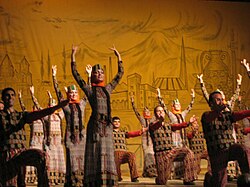Armenian dance
| Part of a series on |
| Armenians |
|---|
 |
| Armenian culture |
| By country or region |
Armenian diaspora Russia |
| Subgroups |
| Religion |
| Languages and dialects |
|
| Persecution |

The Armenian dance (Armenian: Հայկական Պար) heritage has been one of the oldest, richest and most varied in the Near East. From the fifth to the third millennia B.C., in the higher regions of Armenia, the land of Ararat, there are rock paintings of scenes of country dancing. These dances were probably accompanied by certain kinds of songs or musical instruments. In the fifth century Moses of Khoren (Movsés Khorenats'i) himself had heard of how the old descendants of Aram (that is Armenians) make mention of these things (epic tales) in the ballads for the lyre and their songs and dances.

Traditional dancing is still popular among expatriate Armenians, and has also been very successfully `exported' to international folk dance groups and circle dance groups all over the world. The majority of people feel something special in Armenian dances, and in the passion, subtlety, and eloquence which they embody. All dancers wear the traditional costume to embody the history of their culture and bring their ancestors stories alive. The design of these costumes are influenced by many factors, such as religious traditions, family methods, and practicality. The traditional deep red color and exquisite beading of the costumes brings the dance and the tradition together. The beautiful movements of the Armenian cultural dance are adored by all audience around the world. [1]
Religious dancing
The origin of religious dancing is ancient, an expression of the inner feelings of the worshipers. It is of interest to note that dance never occurred alone, but was always accompanied with song, clapping of hands, and musical instruments. As with music, so too the dance expressed a person’s internal spiritual emotions and personal disposition. By its very movements dance is able to bring out and make known a person’s grief and joy.[2]
Folk dances
- Kochari (Քոչարի)- Kochari is one of the most popular dances of Armenians. Kochari is danced in a group of men and women and is known for its tune played in the zurna.
- Shalakho(Շալախո)- A dance for men from Ancient Armenia. It is preformed in dance studios by men, but danced at public gatherings by women as well.
- Tamzara (Թամզարա)
- Yarkhushta (Յարխուշտա)- Yarkhushta is a war dance from the Taron region of Western Armenia .
- Berd (Բերդապար) - Berd is a dance famous for having a circle of men stand on the shoulders of another circle and rotate. Berd means "prison" or "jail" in Armenian and is named accordingly because of the shape the dancers make.
- Shirkhani (Շիրխանի)
- Harsnapar (Հարսնապար)- Harsnapar comes from the Armenian hars which means bride, and par which translates to dance. The bride is shown dancing a solo and may possibly feature the bridesmaids.
- Gorani (Գորանի)
- Gyond (Գյոնդ or Գյովնդ)
- Menapar (Մենապար)- Menapar translates to "solo." It may feature a man or woman. Normally, if a man is the one dancing, the music will be fast-paced and in the case of a woman, a slower, more elegant music will play.
- Nazpar (Նազպար)
- Shurjpar (Շուրջպար)
- Souserapar (Սուսերապար)
- Papuri (Փափուռի)
- Zuykpar (Զույգապար)- Zuykpar is a duet done by a man and woman. It features a liveliness to it and normally includes both dancers doing symmetrical movements.
Regional dances
- Arabkir (Արաբկիրի Պար)- A dance from the Armenian city of Arabkir.
- Kesabian (Քեսապական)- The Kesabian dance came from the city of Kesab, Syria.
- Laz bar - originated among the fishermen of the Black Sea
- Moosh (or Muş, or Mush)(Մշո Պար)- is a mixed dance from the district of Moosh/Daron, west of Lake Van Mush.
- Sasnapar (Սասնապար)- Sasnapar is a more popular dance commo at weddings and other cultural gatherings. It originated in the city of Sasun.
- Vagharshapatian (Վաղարշապատյան)- The Vagharshapatian originated in Vagharshapat now know as Ejmiatsin.
- Zeytouni (Զեյթունի պար)- Zeytouni originated in Zeytun.
Notes
- ^ Gary Lind-Sinanian - ALMA
- ^ "The Shepherd and His Flock"—By Rev. Zenob Nalbandian
- ^ Младенова Т.В. (2010 №177). "Музыкально-исторический процесс в Крыму конца ХIХ начала ХХ столетия" (PDF). Научный журнал «Культура народов Причерноморья». Retrieved 2012-12-25.
{{cite web}}: Check date values in:|date=(help) [1] - ^ Николай Иосифович Эльяш Балет народов СССР. — Знание, 1977. — p. 59. — 166 pp.
See also
External links
- Clips of authentic Kavaragan Armenian Folk Dances from Historical Armenia: Tamzara, Popouri, Laz Bar, Arapkir Bar, Akheltskha Vart, Govduntsi, Bijou, Kessab Bar, Haleh, Shushan, Suleimanli,Shavali. (Archived 2009-10-25)

